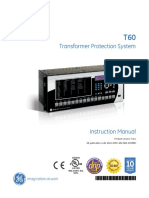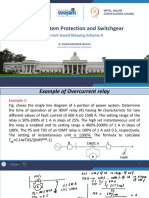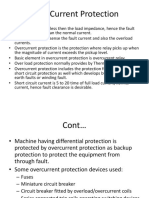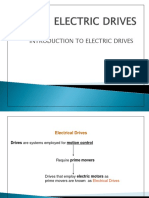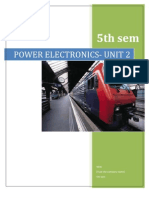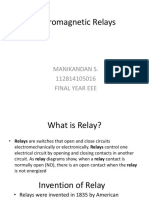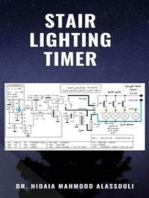DC Motor Protection
DC Motor Protection
Uploaded by
Roy Ferdy MassoloCopyright:
Available Formats
DC Motor Protection
DC Motor Protection
Uploaded by
Roy Ferdy MassoloOriginal Description:
Original Title
Copyright
Available Formats
Share this document
Did you find this document useful?
Is this content inappropriate?
Copyright:
Available Formats
DC Motor Protection
DC Motor Protection
Uploaded by
Roy Ferdy MassoloCopyright:
Available Formats
TECHNICAL
DC Motor Protection
The purpose of DC motor protection is Potential Motor Hazards and ing or cabling faults are related to power
to extend a motor’s lifespan by protect- Fault Conditions source-induced faults, they are catego-
ing it from conditions that can damage A review of motor hazards and com- rized as motor-induced faults.)
that the motor’s windings—both elec- mon fault conditions is useful in un- Load-induced faults (Ref. 2) are “the
trically and mechanically. Motor wind- derstanding the different approaches prolonged overloading as a result of the
ing damage can result from any of the taken to protect motors. These fault application of excessive mechanical
following conditions (Ref. 1): conditions are divided into the follow- load” (Ref. 3). Jamming (locked rotor)
• Mechanical damage ing categories (Ref. 2): is a common load-induced fault that
• Excessive moisture • Motor-induced faults causes an apparent overload or high in-
• High dielectric stress • Load-induced faults ertia (Wk2d). In pump applications, for
• High temperature • Environment-induced faults instance, oil that is cold or highly viscous
• Power source-induced faults may cause a fault; oil heaters are a pos-
While each of the above conditions • Application-induced faults sible solution to correct this fault condi-
can lead to winding damage, the appar- tion.
ent failure is “thermal degradation of Motor-induced faults (Ref. 2) are di- Environment-induced faults (Ref.
the insulation or burnouts. Insulation rectly related to the motor and its asso- 2) include high ambient tempera-
life is reduced by about half for each ciated wiring. Common motor-induced ture, cold/damp environment, high
10o C increase in winding temperature” faults include burnt out insulation, contaminant level and blocked ven-
(Ref. 1). To avoid thermal degradation bad bearings, loss-of-field and other tilation, among others. These condi-
of the insulation, there are a number of mechanical failures. Wiring problems, tions can increase the temperature of
methods, devices and circuits used to chafed or exposed wiring, cabling faults the windings by collecting moisture,
monitor potential motor hazards and or abraded insulation can cause “short degrading by corrosion or insulat-
fault conditions and to de-energize the circuits between power phases or be- ing the windings from contaminants.
motor when these conditions are met. tween a power phase and earth ground Loss of ventilation—especially at low
in the motor winding or its connec- speeds—also increases winding tem-
tions” (Ref. 3). (Note: Even though wir- perature.
Power source-induced faults (Ref. 2)
typically will cause high motor currents
that can thermally degrade the motor
windings from I2R heating. These fault
conditions are numerous and include
over-voltage; under-voltage; phase re-
versal; open phase failures (Ref. 3);
unbalances; ground-faults; power tran-
sients; harmonics; and loss-of-field.
Application induced-faults (Ref. 2)
are caused by operating conditions that
typically cause overcurrent or overload
conditions. These conditions include
high duty cycle; jogging; rapid plugging
(or plug reversing); over-speeding (Ref.
4); and synchronization problems.
Motor Protection Methods
Motor protection methods include
devices and circuits that are used with-
in the motor or used with the motor’s
control circuitry to monitor fault condi-
tions. They include:
• Thermal overload relays
Reprinted with permission from the Resources Section of Ohio Electric’s Internet Website: www.ohioelectricmotors.com.
48 Power Transmission Engineering JUNE 2013 WWW.POWERTRANSMISSION.COM ]————
• Transient voltage protectors
• Ground fault relays off the power line. Bi-metal-strip (Ref. discharging and motorizing the genera-
• Distance relays 5) thermal overloads operate similar tor (Ref. 11).
• Fuses, contactors and circuit to inherent overload protection. While For DC motors, the loss-of-field can
breakers thermal overload protection is most potentially cause a dangerous, over-
• Under-voltage protection commonly used, electronic and mag- speed condition (Ref. 12). Hence, loss-
• Locked rotor protection netic overload protections are also used of-field relays are used to monitor the
• Loss-of-field relays to combat overload (Ref. 8). Electronic motor’s field. They are connected in
• Reversed-current protection overloads are current sensors. They parallel with the field and monitor the
• Isolation transformers sense actual motor current; when the DC motor’s field current. In the event
• Harmonic filters motor current reaches a predetermined that the field current decreases below a
• Power conditioners level, a relay will trip and open the mo- certain limit (Ref. 13), the loss-of-field
tor control circuit. Magnetic overloads relay will drop out and de-energize the
Thermal overload relays (Ref. 5) pro- use electromagnetism to sense an over- motor’s armature.
tect motors from overload conditions. load. When an overload condition is When a motor fails to start or acceler-
There are two main types: inherent and sensed, a relay coil will pull in (close) ate after it’s been energized, it is exhib-
external. Inherent thermal overloads and trip the motor off the power line. iting a locked-rotor condition. In this
(Ref. 6) are bi-metal devices embedded Fuses and circuit protectors are not condition the “motor is subject to ex-
in the motor’s windings. They are essen- overload protectors; rather, they are treme heating, much more so than in an
tially thermostats with two dissimilar overcurrent protectors designed to overload condition since the heat has
metals bound together that will bend to “protect the motor from a direct ground very little time to be dissipated in the
open (in some cases, close) a trip switch or short-circuit condition” in the mo- conductors and other parts of the mo-
(Ref. 7) at a temperature set-point, tor or its associated wiring and cabling tor” (Ref. 14). Locked-rotor conditions
which is proportional to motor current (Ref. 5). Short-circuit protection is in- can be protected by an overcurrent re-
in an overloaded condition. The switch corporated into a motor contactor with lay set for permissible I2t times and cur-
is connected to the motor’s control cir- “high-breaking-capacity fuses” or a rents. But for large DC motors, another
cuitry to alarm and/or de-energize the circuit breaker with “instantaneous at- solution is to build a zero-speed switch
motor. External thermal overload pro- tracted armature-type relays.” Ground into the motor (Ref. 15). If the motor
tection (Ref. 5) involves heaters that are fault relays or interrupters are another does not accelerate to open the zero-
connected in series with the motor’s type of overcurrent protection. They speed switch, the motor’s power sup-
windings and mounted on the motor monitor “unintentional current paths ply is de-energized. However, there’s a
contactor or circuit breaker. There are between a current-carrying conduc- disadvantage to the zero-speed switch;
two types of overloads: solder pot and tor and a grounded surface” (Ref. 9). in situations where the motor starts but
bimetal strip. Solder pot overloads will For motors, ground fault current paths locks up at less than full speed, the zero-
melt when the heat generated by the are typically found through dust, wa- speed switch can close and de-energize
motor current in an overload condi- ter, or worn insulation. Ground faults the motor’s power supply. Locked-rotor
tion occurs; this action opens the mo- pose worker safety hazards (Ref. 10). protection can also be accomplished by
tor control circuit and trips the motor Reverse current relays are a protective a distance relay (Ref. 16).
feature used in motor-generator appli- Power source-induced faults include
For Related Articles Search cations where a standby battery is being under-voltage, overvoltage, open phas-
charged by the generator. The reverse ing, phase rotation and phase imbal-
DC motors current relay prevents the battery from ances. (Note: Generally speaking, phase
at www.powertransmission.com imbalances, phase rotation faults and
JUNE 2013 Power Transmission Engineering 49
TECHNICAL
open phasing are associated with AC type of motor protection and generally tact coil while the reverse coil will en-
motors, and are not addressed in this ar- is used with motor starters for revers- ergize through its NC auxiliary contact.
ticle. But it should be noted that if a DC ing and/or auxiliary control. There are
motor is powered by a DC converter, this three types of interlocks: Environmental Protection
controller protects the motor from these • Mechanical Environmental contamination can
conditions.) (Ref. 17) Under-voltage • Electrical adversely affect normal motor opera-
faults can cause either high motor cur- • Auxiliary contact tion. Dust, air particulates, explosive
rents or a failure to start. Hence, most vapors, water, humidity and high am-
under-voltage protection is part of the Mechanical interlocks will physically bient temperatures can all shorten the
motor starter. However, for prolonged prevent two motor contactors (forward lifespan of a motor. To protect a motor
under-voltage conditions, an inverse- and reverse) from closing simultane- from these environmental conditions,
time-under-voltage-relay can be used ously. “This interlock locks out one the National Electrical Manufacturers
to protect from this condition (Ref. 18). contactor at the beginning of the stroke Association (NEMA) and the Interna-
Rather than using discrete compo- of either contactor.” On the other hand, tional Electro-Technical Commission
nents to protect a DC motor from over- electrical interlocks use a push-button (IEC) have classified motor enclosures
voltages or surges, DC drives, isolation control or auxiliary contact to electri- based upon the level of protection they
transformers (Ref. 19) and power-con- cally isolate one contactor while en- provide (Ref. 26). The two major classi-
ditioning equipment (Ref. 20) are typi- ergizing the other contactor (Ref. 25). fications of motor enclosures are open
cally used to provide this type of protec- Auxiliary contact interlocking is a wir- and totally enclosed. Open motors are
tion. However, MOVs (Ref. 21), arrestors ing modification of push-button inter- further classified as drip-proof, splash-
(Ref. 22), harmonic filters (Ref. 23) and locking. There are two types of auxiliary proof, weather-protected, semi-guard-
power factor correction capacitors can contacts: normally closed (NC) and ed and guarded. Totally enclosed mo-
also provide overvoltage protection normally open (NO). For interlocking tors are classified as totally enclosed
(Ref. 23). protection in a reversing circuit, an NC non-ventilated, fan-cooled, explosion-
auxiliary contact is wired in series with proof, dust ignition-proof, air-to-water
Interlocks: Indirect Motor the opposing motor contactor coil. cooled and air-to-air cooled.
Protection Thus, when a motor is running in the
Interlocking is used to “prevent (mo- forward direction, the forward contact References
tor) contactors from being energized coil is energized through the NC aux- 1. Miller, Rex and Mark R. Miller. Industrial
simultaneously, or closing together iliary contact. When the reverse direc- Electricity and Motor Controls, McGraw-Hill,
2008, p. 384.
and causing a short-circuit (Ref. 24).” In tion is selected, the NC contact will
2. Blackburn, J. Lewis. Protective Relaying:
this respect, interlocking is an indirect open and de-energize the forward con- Principles and Applications, CRC Press, 1998,
p. 358.
3. Electricity Association Services, Ed. Power
System Protection: Application, Vol. 3, 2nd
Ed., Institution of Electrical Engineers, 1995,
p. 164.
4. Blackburn, J. Lewis. Protective Relaying:
Principles and Applications, CRC Press, 1998,
p. 357.
5. Herman, Stephen. Industrial Motor Control,
Cengage Learning, 2009, p. 35.
6. Whitman, William C., William M. Johnson
and John Tomczyk. Refrigeration & Air
Conditioning Technology, Cengage Learning,
2004, p. 365.
7. Marston, R.M. Passive and Discrete Circuits,
Newnes, 2000, p. 84.
50 Power Transmission Engineering JUNE 2013 WWW.POWERTRANSMISSION.COM ]————
8. Tomal, Daniel R. and Neal S. Widmer.
Electronic Troubleshooting, McGraw-Hill
Professional, 2003, p. 99.
9. Zhang, Peng. Advanced Industrial Control
Technology, William Andrew, 2010, p. 766.
10. Blackburn, J. Lewis. Protective Relaying:
Principles and Applications, CRC Press, 1998,
p. 366.
11. Todd, Victor H. Protective Relays: Their
Theory, Design and Practical Operation,
McGraw-Hill, 1922, p. 55.
12. Herman, S. Electrical Transformers and
Rotating Machines, Cengage Learning, 2011,
p. 306.
13. Herman, S. Industrial Motor Control,
Cengage Learning, 2009, p. 16.
14. Elmore, Walter A. Protective Relaying Theory
and Applications, Volume 1, CRC Press, 2004,
p. 149.
15. Blackburn, J. Lewis. Protective Relaying:
Hungry for More
Principles and Applications, CRC Press, 1998,
p. 370.
16. Drbal, Lawrence F., Patricia G. Boston, Kayla
L. Westra and Black & Veatch. Power Plant
Engineering, Springer, 1996, p. 581.
17. Blackburn, J. Lewis. Protective Relaying:
Principles and Applications, CRC Press, 1998,
p. 371.
18. Blackburn, J. Lewis. Protective Relaying:
Everything you
Principles and Applications, CRC Press, 1998,
p. 378.
need if you buy
19. Herman, S. Electrical Transformers and
Rotating Machines, Cengage Learning, 2011,
p. 61.
20. Mardiguian, Michel. EMI Troubleshooting
Techniques, McGraw-Hill Professional, 1999, gears, bearings,
motors, couplings
p. 175.
21. Billings, Keith and Taylor Morey. Switch-
and clutches.
Mode Power Supply Handbook, 3rd Ed.,
McGraw-Hill Prof Med/Tech, 2010, pp. 1–22.
22. Dixit, J.B. and Amit Yadav. Electrical Power
Quality, Laxmi Publications, Ltd., 2010, p. 72.
23. Dixit, J.B. and Amit Yadav. Electrical Power
Quality, Laxmi Publications, Ltd., 2010, p. 73.
24. Herman, S. Electric Motor Control, Cengage
Learning, 2009, p. 165.
25. Herman, S. Industrial Motor Control,
Cengage Learning, 2009, p. 215.
26. Beaty, H. Wayne and James L. Kirtley. Electric
Motor Handbook, McGraw-Hill Professional,
1998, p. 96. • Product and Industry News • Back Issues and Article
Updated Daily Archive
• Directory of Mechanical • Calendar of Upcoming
Power Transmission Events for power
Suppliers transmission professionals
• Exclusive online content in
our e-mail newsletters
www.
powertransmission.com
JUNE 2013 Power Transmission Engineering 51
You might also like
- JCB JS175W Service Manual PDFDocument270 pagesJCB JS175W Service Manual PDFRicardo Vilca100% (11)
- Introduction to Power System ProtectionFrom EverandIntroduction to Power System ProtectionRating: 4 out of 5 stars4/5 (2)
- Kompakt Recu: Series Air Handling Units With C2 Control System Electrical Installation and Operation ManualDocument20 pagesKompakt Recu: Series Air Handling Units With C2 Control System Electrical Installation and Operation ManualRamoNo ratings yet
- T60 741x AE1Document694 pagesT60 741x AE1kumarinelNo ratings yet
- Elec 5204 Review Quizzes AnsDocument9 pagesElec 5204 Review Quizzes Ansveljal6317No ratings yet
- Thermal Stability of I.T. at SiteDocument4 pagesThermal Stability of I.T. at SiteBalubhai KarsanbhaiNo ratings yet
- Practical Guide to International Standardization for Electrical Engineers: Impact on Smart Grid and e-Mobility MarketsFrom EverandPractical Guide to International Standardization for Electrical Engineers: Impact on Smart Grid and e-Mobility MarketsNo ratings yet
- Auto-Transformer Design - A Practical Handbook for Manufacturers, Contractors and WiremenFrom EverandAuto-Transformer Design - A Practical Handbook for Manufacturers, Contractors and WiremenRating: 4 out of 5 stars4/5 (2)
- Protection of Ac Generators and Motors: Generator FaultsDocument10 pagesProtection of Ac Generators and Motors: Generator FaultsasdasasdsdfsdfNo ratings yet
- Power System Protection and Switchgear: Current Based Relaying Scheme-IIDocument13 pagesPower System Protection and Switchgear: Current Based Relaying Scheme-IISampath AnbuNo ratings yet
- Question and Answers Electrical MaintenaDocument416 pagesQuestion and Answers Electrical MaintenaimranNo ratings yet
- Vocational Training ReportDocument15 pagesVocational Training ReportSaroj KumarNo ratings yet
- Note Switchgear PDFDocument36 pagesNote Switchgear PDFNur FatihahNo ratings yet
- Testingcommissioning Blogspot QaDocument5 pagesTestingcommissioning Blogspot QaratheeshkumardNo ratings yet
- Bus Bar Protection: External FaultsDocument4 pagesBus Bar Protection: External FaultsChanderSinghWarkadeNo ratings yet
- Transformer ProtectionDocument22 pagesTransformer ProtectionRuben MaychelNo ratings yet
- Electrical Interview QuestionsDocument3 pagesElectrical Interview QuestionsबिपुलकुँजNo ratings yet
- Over Current ProtectionDocument22 pagesOver Current Protectionnihkinwejkb100% (1)
- How To Choose Circuit Breakers For Electric MotorsDocument2 pagesHow To Choose Circuit Breakers For Electric Motorsحسن التميميNo ratings yet
- Power System Protection and Switchgear: Current Based Relaying Scheme-VDocument16 pagesPower System Protection and Switchgear: Current Based Relaying Scheme-VSampath AnbuNo ratings yet
- Milli Volt DropDocument2 pagesMilli Volt Dropkazishah100% (1)
- EEC Unit VIDocument8 pagesEEC Unit VITushar Shinde100% (2)
- Continue To Provide Torque When Stalled)Document5 pagesContinue To Provide Torque When Stalled)saiNo ratings yet
- SUB U - T2-Protection Relay Report - UpdatedDocument6 pagesSUB U - T2-Protection Relay Report - UpdatedNagaraj VjNo ratings yet
- UPPCL Technical Interview Question Paper 2011 Placement Model Question Paper JbigDeaLDocument4 pagesUPPCL Technical Interview Question Paper 2011 Placement Model Question Paper JbigDeaLmohitu_20% (1)
- Sail Rourkela Solve Question 2019: Allexamreview - inDocument28 pagesSail Rourkela Solve Question 2019: Allexamreview - inArun KumarNo ratings yet
- SF6 Circuit Breaker Nameplate Details Explanation - Electrical4uDocument8 pagesSF6 Circuit Breaker Nameplate Details Explanation - Electrical4uHawaz BeyeneNo ratings yet
- Industrial Training ReportDocument25 pagesIndustrial Training Reportankitsingh19092003No ratings yet
- Aed Unit3Document68 pagesAed Unit3Anser Pasha100% (1)
- Protection Relays Interview Questions & Answers - Engineering TutorialDocument3 pagesProtection Relays Interview Questions & Answers - Engineering TutorialPabitra Kumar PatraNo ratings yet
- Oil Circuit BreakersDocument25 pagesOil Circuit Breakersjaimito=)100% (1)
- Study of KV Switch YardDocument35 pagesStudy of KV Switch YardRamana Paravastu100% (1)
- Buchholz Relay-Working, Construction, Application, Diagram, AdvantagesDocument5 pagesBuchholz Relay-Working, Construction, Application, Diagram, AdvantagesBruno TavaresNo ratings yet
- Wave TrapDocument24 pagesWave TrapAbhinav KumarNo ratings yet
- MetrosilDocument4 pagesMetrosilSuranjana DasNo ratings yet
- ADR219 CMDocument133 pagesADR219 CMRajiv ChandranNo ratings yet
- Interview QuestionDocument15 pagesInterview QuestionNadeem AhmedNo ratings yet
- Ac Power Distribution Switch BoardDocument26 pagesAc Power Distribution Switch BoardKoushik BhaumikNo ratings yet
- CBCTDocument14 pagesCBCTYPV TECHNICAL SERVICES100% (2)
- High Voltage Engineering: Unit-I Electric Field StressesDocument9 pagesHigh Voltage Engineering: Unit-I Electric Field StressesmaheshNo ratings yet
- Circuit Breaker Specifications Mentioned On Its NameplateDocument13 pagesCircuit Breaker Specifications Mentioned On Its Nameplatearyo bimo surya putraNo ratings yet
- Power Electronics 2 MarkDocument5 pagesPower Electronics 2 MarkPrakash Mahendran100% (2)
- Ee1302 Protection and SwitchgearDocument12 pagesEe1302 Protection and SwitchgearMukesh Kumar0% (1)
- Auto RecloserDocument16 pagesAuto RecloserMohammedHaythamNo ratings yet
- Substation Electrical Protection 1Document31 pagesSubstation Electrical Protection 1Saravanan PNo ratings yet
- ANSI Device NumbersDocument7 pagesANSI Device Numbersrajpre1213100% (1)
- Power Factor Meters - Electrodynamometer Type Power Factor MeterDocument4 pagesPower Factor Meters - Electrodynamometer Type Power Factor MeterNh Chuminda Yapa0% (1)
- Introduction of Electric Power SystemDocument17 pagesIntroduction of Electric Power SystemsohaibNo ratings yet
- Electromagnetic Relays - ManiDocument17 pagesElectromagnetic Relays - ManipraveenaprabhuNo ratings yet
- Tap Position Transducer Model: Tc-02 User'S Manual: Instrument Front & Side ViewDocument2 pagesTap Position Transducer Model: Tc-02 User'S Manual: Instrument Front & Side ViewBhageerathi SahuNo ratings yet
- Micom P225 Motor Protection RelayDocument12 pagesMicom P225 Motor Protection RelayJatinder SainiNo ratings yet
- Industrial Electrical Power System ProtectionDocument5 pagesIndustrial Electrical Power System ProtectionRAPRATSIN100% (1)
- A Presentation ON Overhead Line Insulators Faculty: Gunjan VarshneyDocument67 pagesA Presentation ON Overhead Line Insulators Faculty: Gunjan VarshneyGunjan VarshneyNo ratings yet
- Chapter Three: Operation of Auto Recloser and Sectionalizer 3.1.Document14 pagesChapter Three: Operation of Auto Recloser and Sectionalizer 3.1.Umar Wijaksono100% (1)
- Electrical Protection SystemsDocument158 pagesElectrical Protection SystemsMohammad TammamNo ratings yet
- Power QualityDocument69 pagesPower Qualityparamak958No ratings yet
- Chapter 4 Protection of Alternator TransformerDocument33 pagesChapter 4 Protection of Alternator TransformerPrEmNo ratings yet
- 24-IDL-EE 466-UNIT 3-Technical Aspects of Power Systems Planning PDFDocument24 pages24-IDL-EE 466-UNIT 3-Technical Aspects of Power Systems Planning PDFjenyonamsurveyNo ratings yet
- Schematics - Back BuzzerDocument1 pageSchematics - Back BuzzerRoy Ferdy MassoloNo ratings yet
- Wiring Diagram For Base Module (GM) 1Document8 pagesWiring Diagram For Base Module (GM) 1Roy Ferdy MassoloNo ratings yet
- Presentation MF5700 - Technical InformationDocument104 pagesPresentation MF5700 - Technical InformationRoy Ferdy MassoloNo ratings yet
- Wiring Diagram For AlternatorDocument2 pagesWiring Diagram For AlternatorRoy Ferdy MassoloNo ratings yet
- 70161kerax PNG AnDocument170 pages70161kerax PNG AnRoy Ferdy MassoloNo ratings yet
- Capacity Vs CCADocument3 pagesCapacity Vs CCARoy Ferdy MassoloNo ratings yet
- Angle Sensor 424sDocument6 pagesAngle Sensor 424sRoy Ferdy MassoloNo ratings yet
- 2.service KitDocument1 page2.service KitRoy Ferdy MassoloNo ratings yet
- 2.LOAD CHART AT-22 T133750C (Color) PDFDocument21 pages2.LOAD CHART AT-22 T133750C (Color) PDFRoy Ferdy MassoloNo ratings yet
- Basics of AC Drives PDFDocument120 pagesBasics of AC Drives PDFRoy Ferdy MassoloNo ratings yet
- V4073A Installation GuideDocument2 pagesV4073A Installation GuidemohamednavaviNo ratings yet
- Maintenance Manual: Thermo King Europe - Monivea Road - Mervue, Galway - IrelandDocument10 pagesMaintenance Manual: Thermo King Europe - Monivea Road - Mervue, Galway - IrelandVincent MarmandeNo ratings yet
- Φ630 Cantilever frame Single-twist Cabling MachineDocument3 pagesΦ630 Cantilever frame Single-twist Cabling Machinetees220510No ratings yet
- Bin HarmoniDocument137 pagesBin HarmonijokoNo ratings yet
- T 1201Document45 pagesT 1201Alex Emerson Pupiales0% (1)
- Iso Es CB InterlocksDocument80 pagesIso Es CB Interlocksgkpalepu86% (7)
- Bowens Illumitran 3Document22 pagesBowens Illumitran 3vicentolueNo ratings yet
- Unit 7 & 8 Turbine House Main Equipments Echnical SpeccificationDocument20 pagesUnit 7 & 8 Turbine House Main Equipments Echnical SpeccificationAshek UllahNo ratings yet
- 頁面擷取自 ED3051G442Document2 pages頁面擷取自 ED3051G442QooNo ratings yet
- SpreadsheetDocument3 pagesSpreadsheetPratheeksha ShivkumarNo ratings yet
- Pioneer Deh 2800mp Deh 2850mpDocument72 pagesPioneer Deh 2800mp Deh 2850mpLasertech Módulos0% (1)
- Válvula de Cuchillo Ac CarbonoDocument2 pagesVálvula de Cuchillo Ac CarbonoEme Eme LorcaNo ratings yet
- Rfoui-250v 2014Document5 pagesRfoui-250v 2014VENITHA KNo ratings yet
- 27f Line Break PermitDocument2 pages27f Line Break PermitMohammed MinhajNo ratings yet
- Takex PB-IN-50HF Data SheetDocument2 pagesTakex PB-IN-50HF Data SheetJMAC SupplyNo ratings yet
- IEC 309 Pin and Sleeve Devices: NEMA 4X-IP67 Industrial Versions Zone 1 & 2, Division 2 VersionsDocument20 pagesIEC 309 Pin and Sleeve Devices: NEMA 4X-IP67 Industrial Versions Zone 1 & 2, Division 2 VersionsMasterGNo ratings yet
- Interface Engineering Company: List of Construction MachinesDocument2 pagesInterface Engineering Company: List of Construction MachinesMian M KhurramNo ratings yet
- Carr Lane 2019 PDFDocument749 pagesCarr Lane 2019 PDFhehc2No ratings yet
- Adjustable Torque Wrenches Adjustable Torque Wrenches & Preset DriversDocument1 pageAdjustable Torque Wrenches Adjustable Torque Wrenches & Preset DriversGeorge Yánez CajasNo ratings yet
- E PipeAlator PDFDocument1 pageE PipeAlator PDFCharlieNo ratings yet
- Catalogo Itap ActualizadoDocument98 pagesCatalogo Itap Actualizadodistri.suarezporrasNo ratings yet
- PC Usage and Purchase Journey Share by WorldLine TechnologyDocument18 pagesPC Usage and Purchase Journey Share by WorldLine TechnologyDuy Nguyen Ho ThienNo ratings yet
- Versamax Ip: Programmable Control ProductsDocument54 pagesVersamax Ip: Programmable Control ProductsEDBNo ratings yet
- Stock PH 22-7-2022Document70 pagesStock PH 22-7-2022ariniNo ratings yet
- Similar Building As Above Constructed in Following CountriesDocument1 pageSimilar Building As Above Constructed in Following CountriesSuhail AhamedNo ratings yet
- HT162 - 7845541.1 - Spare Parts Catalogue - INGDocument152 pagesHT162 - 7845541.1 - Spare Parts Catalogue - INGmadani.hanacheNo ratings yet
- The Sollatek Freocom Fcr32: Instruction ManualDocument9 pagesThe Sollatek Freocom Fcr32: Instruction ManualGrucito KonfyNo ratings yet
- Lighting Lighting: Essential Smartbright G4 Led Floodlight Bvp150Document2 pagesLighting Lighting: Essential Smartbright G4 Led Floodlight Bvp150Bankhar TradingNo ratings yet



